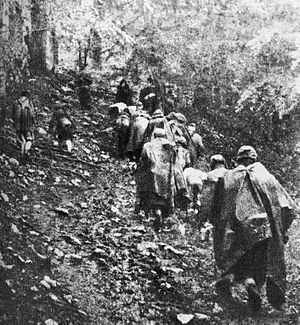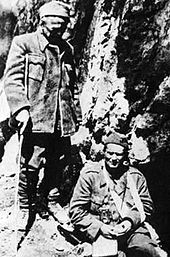- Battle of the Sutjeska
-
For the film, see Sutjeska (film).
Battle of the Sutjeska Part of the Yugoslav Front of World War II 
Partisan column during the Battle of the SutjeskaDate May 15 – June 16, 1943 Location Vicinity of the Sutjeska river, southeastern Bosnia, occupied Yugoslavia Result Axis tactical victory, but failure in achieving mission goals, heavy Partisan casualties Belligerents Axis:
 Germany
Germany
Allies:
 Partisans
PartisansCommanders and leaders  Alexander Löhr
Alexander Löhr
 Rudolf Lüters
Rudolf Lüters Josip Broz Tito
Josip Broz TitoStrength 127,000 men
300+ aircraft22,148 men Casualties and losses comparably low 7,543 The Battle of the Sutjeska (Serbo-Croatian: Bitka na Sutjesci, Битка на Сутјесци, pronounced [bîtka na sûtjɛst͡si]), codenamed Fall Schwarz, was a joint attack by the Axis taking place from 15 May to 16 June 1943, which aimed to destroy the main Yugoslav Partisan force, near the Sutjeska river in south-eastern Bosnia. The failure of the offensive marked a turning point for Yugoslavia during World War II.
The operation is generally known as the Fifth anti-Partisan Offensive, while it is also known as the Fifth Enemy Offensive (Peta neprijateljska ofenziva/ofanziva) in ex-Yugoslav terminology. Codenamed Fall Schwarz, it immediately followed Fall Weiss which had failed in accomplishing the same objectives: to eliminate the central Partisan formations and capture their commander, Josip Broz Tito, also known by his Comintern codename as "Walter".
Contents
Operation
The Axis rallied 127,000 land troops for the offensive, including German, Italian, NDH, Bulgarian, Greek forces under Georgios Poulos (officially SS) and Cossack (in ex-Yugoslav sources also called "Čerkezi", Cherkes) units, and over 300 airplanes. The Yugoslav National Liberation Army had 22,148 soldiers in 16 brigades.[4] After a period of troop concentration, the offensive started on 15 May 1943. The Axis troops used the advantage of better starting positions to encircle and isolate the partisans on the Durmitor mountain area, located between the Tara and Piva rivers in the mountainous areas of northern Montenegro and forced them to engage in a fierce month-long battle on waste territory.
On June 9, Tito was nearly killed, as a bomb fell near the leading group and wounded him in the arm. The popular post-war report of the event credited Tito's German shepherd dog Luks, for sacrificing his life to save Tito's.[5] Captain William F. Stuart, a Special Operations Executive operative who was parachuted into Tito's headquarters alongside Captain William Deakin during May,[6] was killed by the explosion, as well.[7]
Facing almost exclusively German troops, the Yugoslav National Liberation Army (YNLA) finally succeeded in breaking out across the Sutjeska river through the lines of the German 118th and 104th Jäger and 369th SS (Croatian) Infantry divisions in the northwestern direction, towards Eastern Bosnia. Three brigades and the central hospital with over 2000 wounded were surrounded. Following Hitler's instructions, German commander in chief General Alexander Löhr ordered and carried out their annihilation, including the wounded and the unarmed medical personnel. In addition, YNLA troops suffered from severe lack of food and medical supplies, and many were struck down by typhoid.
In total there were 7,543 partisan casualties, more than a third of the initial force.[4] The German commander in field, general Rudolf Lüters in his final report described the so-called "communist rebels" as "well organized, skillfully led and with combat morale unbelievably high".
The successful Partisan breakout helped their reputation as a viable fighting force with the local populace. Consequently they were able to replenish their losses with new recruits, regroup, and mount a series of counterattacks in Eastern Bosnia, clearing Axis garrisons of Vlasenica, Srebrenica, Olovo, Kladanj and Zvornik in the following 20 days.
The battle marked a turning point toward Allied control of Yugoslavia, and became an integral part of the Yugoslav post-war mythology, celebrating the self-sacrifice, extreme suffering and moral firmness of the partisans.
Order of battle
Allied order of battle
 Yugoslav Partisans (Partisans Main Operational Group)[8]
Yugoslav Partisans (Partisans Main Operational Group)[8]- 1st Proletarian Division
- 2nd Proletarian Division
- 3rd Assault Division
- 7th Banija Division
- 3rd Dalmatian Brigade
- 3rd Battalion, 4th Proletarian Brigade
- 2nd and 4th Battalions, 5th Montenegrin Brigade
Axis order of battle
- 7th SS Volunteer Mountain Division Prinz Eugen
- 1st Mountain Division
- 104th Jäger Division
- 118th Jäger Division
- 369th (Croat) Infantry Division
- 13th Waffen Mountain Division of the SS Handschar (1st Croatian)
- elements of the Brandenburg Regiment
- reinforced 724th Infantry Regiment (104th Division)
- 1 Alpine Division Taurinense
- 19 Infantry (Mountain) Division Venezia
- 23 Infantry Division Ferrara
- 32 Infantry Division Marche
- 151 Infantry Division Perugia
- 154 Infantry Division Murge
- forces of Sector Podgorica
- 4th Home Guard Jäger Brigade
- 63rd Infantry Regiment
- 61st Infantry Regiment also in the area
(both units under the command of the German 369th Division)
In Film
Battle of Sutjeska was made into a movie in 1973, Sutjeska, with Richard Burton playing the lead as Josip Broz Tito, leader of the partisan forces.
In Song
There are several songs about the Battle of Sutjeska. One of the more popular is called Sivi Sokole which translates to Peregrine Falcon. It mentions the death of Commander Sava Kovacevic.
Bosnian/Croatian/Serbian English Sivi sokole, prijatelju stari, Daj mi krila, sokole da preletim planine.
Visoka je planina, nebo iznad nje, A na nebu sivi soko, gleda na mene.
Duboka je Sutjeska, kanjon iznad nje Na kanjonu Tito stoji, gleda ranjene
Na kanjonu Tito stoji i poručuje Sutjeska se mora proći, da spasimo ranjene Sivi sokole...
Sutjeska je probijena, ranjeni su spašeni A naš stari heroj Sava osta mrtav da leži Sivi sokole...
Radili smo, radimo, radit ćemo još Druže Tito, kunemo se, pobijedit ćemo
Peregrine Falcon, old friend of mine, Give me wings falcon so that I can fly over the mountains.
The mountain is high, and the sky above it And in the sky the peregrine falcon looks upon me.
The Sutjeska river is deep, the canyon is above it On the canyon Tito stands, watches over the wounded
On the canyon Tito stands and commands The Sutjeska must be crossed to save the wounded Peregrine falcon...
The sutjeska is passed, the wounded are saved But our old hero Sava lies dead Peregrine falcon...
We worked, we work, we will work still Comrad Tito, we pledge, we will triumph.
Memorial complex
 Monument commemorating the Battle of the Sutjeska in Tjentište, Bosnia and Herzegovina.
Monument commemorating the Battle of the Sutjeska in Tjentište, Bosnia and Herzegovina.
Sculptor Miodrag Živković designed the memorial complex, dedicating to the Battle of the Sutjeska in the 1970s. [10] The complex contains frescos by the Croatian artist Krsto Hegedušić.[11]
See also
- Yugoslav Partisans
- Yugoslav Front
- Seven anti-Partisan offensives
- Sava Kovačević
- Resistance during World War II
- Anti-partisan operations in World War II
References
- ^ J. B. Tito, The Yugoslav Road, 99
- ^ Slobodan Nešović, Yugoslav-Bulgarian Relations, 1941-1945, 95
- ^ Jozo Tomašević, The Chetniks, 199
- ^ a b Hoare, Marko Attila (2006). Genocide and Resistance in Hitler's Bosnia: The Partisans and the Chetniks. Oxford University Press. p. 341. ISBN 0197263801.
- ^ Doder, Duško (1979). The Yugoslavs. Vintage Books. p. 130. ISBN 978-0394741581.
- ^ Gilbert, Martin (1971). Winston S. Churchill: Challenge of War 1914-1916. Houghton Mifflin. p. 319. ISBN 978-0395131534.
- ^ Ritchie, Sebastian (2004). Our Man In Yugoslavia: The Story of A Secret Service Operative. Routledge. p. 46. ISBN 978-0714655598.
- ^ Operation SCHWARZ – NOVJ Main Operation Group – Order of Battle
- ^ Operation SCHWARZ – Axis Order of Battle
- ^ Miodrag Živković. [1]
- ^ Renata Jambrešić Kirin. The Politics of Memory in Croatian Socialist Culture: Some Remarks
External links
Yugoslav Front Overview Participants People 1941:
1942:
1943:
- Battle of the Neretva (Fourth Offensive)
- Battle of the Sutjeska (Fifth Offensive)
1944:
- Sixth Offensive
- Raid on Drvar (Seventh Offensive)
- Operation Halyard
- Belgrade Offensive
- Kosovo Operation
1945:
- Syrmian Front
- Battle on Lijevča field
- Bar massacre
- Battle of Poljana
Macedonia:
Strategic bombing:
 Partisans
Partisans
 People's Liberation Army of Macedonia (Partisan faction in Macedonia)
People's Liberation Army of Macedonia (Partisan faction in Macedonia)
 Soviet Union (limited involvement, 1944-45)
Soviet Union (limited involvement, 1944-45) Bulgaria (limited involvement, 1944-45)
Bulgaria (limited involvement, 1944-45) National Liberation Movement (limited involvement, 1944-45)
National Liberation Movement (limited involvement, 1944-45)
 Royal Yugoslav Army (limited involvement, 1941)
Royal Yugoslav Army (limited involvement, 1941) Chetniks (nominally Allied, lost official Allied support in 1943)
Chetniks (nominally Allied, lost official Allied support in 1943)
 Germany
Germany Italy (1941-43)
Italy (1941-43) Albania (1941-44)
Albania (1941-44) Hungary (1941-44)
Hungary (1941-44) Bulgaria (1941-44)
Bulgaria (1941-44) Independent State of Croatia (NDH)
Independent State of Croatia (NDH)
- Croatian Armed Forces (HOS)
- Ustaše Militia (including the Black Legion)
- Croatian Home Guard
- Air Force of the Independent State of Croatia
- Croatian Air Force Legion
 Nedić regime
Nedić regime
- Serbian State Guard
- Serbian Volunteer Corps
 Pećanac Chetniks
Pećanac Chetniks- Russian Corps
 Slovene Axis supporters
Slovene Axis supporters
- White Guards
- Slovenian Home Guard
- Legion of Death
- Upper Carniola Home Guard
- Slovene National Security Force
 Montenegro
Montenegro
- Lovćen Brigade (Zelenaši movement, 1942-44)
- Montenegrin People's Army (former members of the Chetnik movement, 1945)
 Josip Broz Tito
Josip Broz Tito Milovan Đilas
Milovan Đilas Aleksandar Ranković
Aleksandar Ranković Kosta Nađ
Kosta Nađ Peko Dapčević
Peko Dapčević Koča Popović
Koča Popović Petar Drapšin
Petar Drapšin Svetozar Vukmanović Tempo
Svetozar Vukmanović Tempo Arso Jovanović
Arso Jovanović Sava Kovačević †
Sava Kovačević † Ivan Gošnjak
Ivan Gošnjak
 Draža Mihailović
Draža Mihailović Ilija Trifunović-Birčanin
Ilija Trifunović-Birčanin Dobroslav Jevđević
Dobroslav Jevđević
 Maximilian von Weichs
Maximilian von Weichs Alexander Löhr
Alexander Löhr Edmund Glaise von Horstenau
Edmund Glaise von Horstenau Mario Roatta
Mario Roatta Ante Pavelić
Ante Pavelić Dido Kvaternik
Dido Kvaternik Milan Nedić
Milan Nedić Kosta Pećanac
Kosta Pećanac Sekule Drljević
Sekule Drljević Leon Rupnik
Leon Rupnik
Categories:- Seven anti-Partisan offensives
- Yugoslavia in World War II
- World War II Eastern European Theatre
- Battles involving Yugoslavia
- Anti-partisan operations of World War II
- Military operations of World War II involving Germany
- Battles involving the Independent State of Croatia
- Battles involving Bulgaria
Wikimedia Foundation. 2010.

